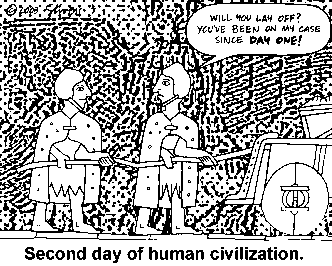
Anthropology
2031-01 (4727)
|
 |
COURSE OUTLINE
..
..
Notes #1 Chazan, Michael: Putting the Picture Together. Pp. 37-59. In World Prehistory and Archaeology: Pathways through Time. Pearson Education. 2008. Childe, V. Gordon. The Urban Revolution. Pp. 6-14. In Lamberg-Karlovsky, C.C. & Jeremy A. Sabloff. The Rise And Fall of Civilizations. Cummings Publishing Company. 1974. Buren,
Mary Van & Janet Richards. Introduction: ideology, wealth, and the
comparative study of “civilizations.” Pp. 3-12. In Order,
Legitimacy, and Wealth in Ancient States. Part I: Order, Legitimacy, and
Wealth in Ancient States. Cambridge University Press. 2000.
Meeting
# 2 - May 14, 2008
Required readings: Notes # 2. Chazan, Michael: Mesopotamia. Pp. 323-334. In World Prehistory and Archaeology: Pathways through Time. Pearson Education. 2008. Cooper, Jerrold S.: Babylonian Beginnings: The Origin of the Cuneiform Writing System In Comparative Persepctive. Pp. 71-99. In Houston, Stephen G. ed. The First Writing: Script Invention and Process. Cambridge University Press. 2004. Future/optional reading (absolutely great and fun to read): Kramer,
Samuel Noah. History Begins in Sumer. The University of Pennsylvania
Press. 1981.
Meeting
# 3 - May 19, 2008
Required readings: Notes # 3. Redford, Donald B. The Ancient Egyptian “City”: Figment or Reality? Pp. 210-220. In Aufrecht, Walter E., Neil A. Mirau & Steven W. Gauley eds. Urbanism in Antiquity. Sheffield Academic Press. 1997. Routledge, Carolyn. Temple as the Center in Ancient Egyptian Urbanism. Pp. 221-235. In Aufrecht, Walter E., Neil A. Mirau & Steven W. Gauley eds. Urbanism in Antiquity. Sheffield Academic Press. 1997. Chazan, Michael: Egypt. Pp. 360-375. In World Prehistory and Archaeology: Pathways through Time. Pearson Education. 2008. Future/optional readings (fun, fun, fun): Almost
anything about ancient Egyptian religion. (Avoid those without pictures).
Week
# 4 - May 21, 2008
Summary with movies. Review. Mesopotamia. I Have Conquered the River. CB 311 M48 2003 v. 2. Egypt: Journey to the Global Civilization. CB 311 M48 2003 v. 1. TAKE HOME EXAM - to be returned on June 4, 2008
|
||||||||||||||||||||||||||||||
Meeting # 5 - May 26, 2008 MEMORIAL DAY HOLIDAY! |
||||||||||||||||||||||||||||||
Meeting
# 6 - May 28, 2008
Required readings: Notes # 5-6 Tsipopoulou, Metaxia. Palace-Centered Polities in Eastern Crete: Neopalatial Petras and Its Neighbors. Pp. 263-277. In Aufrecht, Walter E., Neil A. Mirau & Steven W. Gauley eds. Urbanism in Antiquity. Sheffield Academic Press. 1997. Wolff, Walther. The Aegean. Pp. 165-203. In Early Civilizations: Egypt, Mesopotamia, the Aegean. The Herbert Press. 1989. Check also: www.ou.edu/finearts/art/ahi4913/aegean.html and www.daedalus.gr/DAEI/THEME/Knossos.htm Future/optional readings: Works
of Homer. You should go through them at least once in your life.
Meeting
# 7 - June 2, 2008
Required readings: Notes # 7 Dunstan, William E. Chapter VIII. The Hittites of Anatolia and Their Contemporaries. Pp. 154-175. In The Ancient Near East. Harcourt Brace College Publishers. 1998. Check also: www.allaboutturkey.com/hitit.htm Balter, Michael: The First Cities: Why Settle Down? The Mystery of Communities. In Science 20, November 1998: Vol. 282.no.5393, p. 1442 (www.sciencemag.org/cgi/content/full/282/5393/1442). For more general information about Çatal Hüyük check also: http://wcuww.com/civcty/cathyk00.htm For scientific reports check: www.catahoyuk.com Future/optional reading: Macqueen, J.G. The Hittites and Their Contemporaries in Asia Minor. Thames and Hudson. 1986. Balter, Michael. Çatal Hüyük: An Archaeological Journey to the Dawn of Civilization. Free Press. 2005.
Required readings: Notes # 8 Patterson, Thomas C. Harappan Society: Class-stratified or kin-based? Pp. 141-146. In Archaeology. The Historical Development of Civilizations. Prentice Hall. 1993. Chazan, Michael: The Indus Valley. Pp. 375-380. In World Prehistory and Archaeology: Pathways through Time. Pearson Education. 2008. Check also: www.harappa.com/har/har0.html Future/optional reading (very informative): Kenoyer, Jonathan Mark. Ancient Cities of the Indus Valley Civilization. Oxford University Press. 1998. Movie: TAKE
HOME EXAM - to be returned on June 18, 2008 Meeting
# 9 - June 9,
2008
Required readings: Notes # 9-10 Barnes, Gina L. Chapter 12. The Making and Breaking of Empire. 220 B.C. - A.D. 500. Pp. 192-207. In The Rise of Civilization in East Asia: The Archaeology of China, Korea and Japan. Thames & Hudson. 1999. Di Cosmo, Nicola. Those Who Draw the Bow. The Rise of the Hsiung-nu Nomadic Empire and the Political Unification of the Nomads. Pp. 161-205. In Ancient China and Its Enemies. The Rise of Nomadic Power in East Asian History.Cambridge University Press. 2002. Chazan, Michael: Shang China. Pp. 350-355. In World Prehistory and Archaeology: Pathways through Time. Pearson Education. 2008. Check also: www.ess.uci.edu/~oliver/silk.html and www.chinaknowledge.de/History/Myth/shang.html Future/optional reading (very interesting but also confusing at times): Di Cosmo’s whole book. Movies:
Meeting # 10 - June 11, 2008 |









 IMPORTANT!!!
IMPORTANT!!!